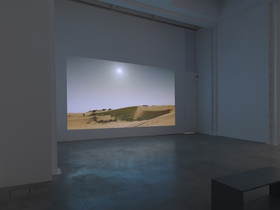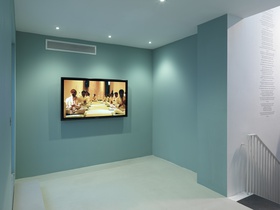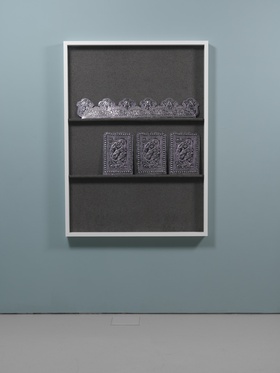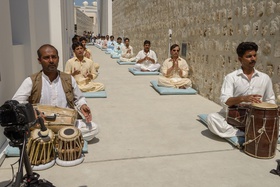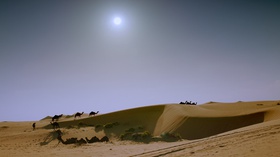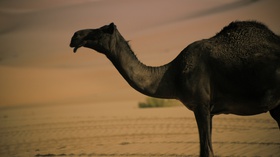Interviews
Narrative Treatments
Wael Shawky in conversation with Stephanie Bailey
Wael Shawky's work explores the cycles of history and myth – those narrative structures that both produce and propagate society's various belief systems, from the religious to the political. His multi-layered film projects include the series Cabaret Crusades (2010-ongoing), which tells the story – through the use of marionettes – of the Crusades (the military expeditions to the Holy Land undertaken by European Christians from the eleventh to the thirteenth centuries) as based on Amin Maalouf's book The Crusades Through Arab Eyes. Meanwhile, with his two-part film Al Araba Al Madfuna (2012), Shawky explores the ritual of treasure digging in Upper Egypt, set against the narrative backdrop of writer Mohamed Mustagab's parables. Shawky recently opened two exhibitions in London at Lisson Gallery (to 8 March 2014), which extends on a performance he produced at the 11th Sharjah Biennial entitled Dictums, and the Serpentine Galleries (to 9 February 2014), in which the artist presents a mixture of old and new works. This interview explores Shawky's treatment of narratives within his practice, as both a form for composition and a frame for conceptual critique.
Stephanie Bailey: I wanted to begin with Dictums, a performance you produced for the 11th Sharjah Biennial in 2013, in which qawwali singers were invited to sing, in Urdu, the press releases and statements from the 10th Sharjah Biennial in 2011. How did the composition of this work come about?
Wael Shawky: I was invited to do a residency called the 'Witness Programme', which involved visiting the 10th Sharjah Biennial and either writing something about it, responding to it or giving a talk. Instead, I decided to make a project that described the biennial as a small society, which could work as a metaphor for art institutions and their relationships with local communities. I did this because in the press release and the press conference, a lot was said about bridging the gaps between the local community and contemporary art, and I didn't understand how this could happen in a place like Sharjah.
So, I spent time there during the preparation for the biennial, during the biennial itself and stayed after the opening days, when the biennial became completely empty and you only saw workers inside the venues cleaning – these were the same people who installed the work. I thought it would be interesting to make a project about the biennial from the point of view of these people who were working inside the context of Sharjah, because to me they were really the local community, who were basically excluded from the scene. Of course, this happened for many reasons. And of course Sharjah is a very important and international biennial and I have a lot of respect for the biennial itself. When I proposed working on this project and showing it in the biennial that would follow on from the 10th Sharjah Biennial, the idea was accepted. That was very simple.
SB: And the idea of translating the press releases of the 10th Sharjah Biennial into Urdu...how did you decide on this?
WS: That came through the workshops I put on with the workers at the foundation. I wanted to give them the authority for this project, rather than myself, so the first thing I decided to do was translate everything into Urdu so that these texts could be read and understood. Of course, I don't understand Urdu, so I didn't understand most of the discussions that took place in the workshops. In this way, it was really me working with my own ignorance.
SB: This also reverses the authority of language, in that you were placed in the position of incomprehension. This raises ideas of exclusion that you were thinking about in terms of how the local community might engage with the language of contemporary art, or even how it might engage with a society whose language they don't understand…
WS: Yes, exactly.
SB: And you translated all of the transcripts of the press conferences?
WS: Yes everything, because the press conferences happened in three cities: Dubai, London and New York. Even if someone said something unimportant, everything was translated; things had to be recorded completely as they were. This was interesting because even within this translation, different meanings occurred. But this happens in all the work I make. It's that idea of dealing with historical texts, for example, as if they were sacred – this idea of dealing with them precisely. With the translation in Dictums, this was part of the analysis; part of criticizing the way we believe in curatorial discourse as something sacred.
SB: How did the workers respond to the press conference material?
WS: I feel that they had completely different concerns. We were talking about something that is, for them, very luxurious. This is exactly what Dictums is about: how we are talking about these big conferences that use all these philosophical terms. Because in the end, this is the local community and it has no real connection to any of the discourses. That was the idea.
SB: When it came to composing these translated press releases into song, how did you come to the decision to use qawwali music?
WS: At the start of the project, I really didn't know what type of music I would use, though I knew I wanted to make a composition. Everything stemmed from research. During the workshops there was a vote on what type of music the workers would like to use and most people voted for qawwali music.
SB: How did the local community receive the work when you presented it at the 11th Sharjah Biennial opening in 2013?
WS: They loved it. But I also made a lot of mistakes. Initially I asked to stage the performance in one of the white rooms at the Biennial, to become like a closed white cube, which would have been a clear institutional critique. But in the end I'm glad it did not work to have the performance inside one of those boxes. I felt that everything led to that idea of the corridor, which was the perfect message.
SB: Yes, the corridor felt like a mediatory zone. In thinking about this, what was interesting about Dictums was that it came after 2011 and everything that had happened with Jack Persekian and the so-called 'Arab Spring'. The 2012 Sharjah March Meeting was an incredibly heated affair as a result of these events, and it is clear this fed into the conceptualization of the 2013 Sharjah Biennial. As a performance, it felt like Dictums also took those events of 2011 to produce a work that acted more as a mediation than a provocation. Aside from this, were there other factors that were feeding into this work?
WS: Yes, of course. Between my experience in Sharjah and my experience in Karachi, where I went to work with the qawwali musicians, a lot of discussions took place, which was a beautiful experience for me. I also thought about the idea of importing and exporting. As an idea, it was interesting for me to go to Karachi to choose qawwali musicians, who are mainly Sufi religious singers, and bring them to Sharjah to sing at the biennial's opening press conference. This was a translation for me, and actually every single moment of that project became a translation of my experience in the Gulf. I grew up in the Gulf in Saudi Arabia, so Dictums was also part of my personal history.
SB: The exhibition you are presenting at Lisson Gallery is also titled Dictums: how is this an extension of the project in Sharjah?
WS: It is an extension, but I'm not looking to make the same performance anywhere else again, because it was very specific in terms of how it was produced and presented. So when thinking about this show, I decided I could not bring qawwali singing to London. Instead, the idea was to show only the sound installation and a silent documentary of the performance. Also, as a continuation of this, I included a series of new vitrine works that are responses to my experience of Pakistan. People there decorate their trucks, buses and sometimes the food carts with things that they make out of aluminium and stainless steel – handmade decorative things, these types of cheap, kitschy decorations and adornments. While I was in Karachi, I had some special objects made using the same aluminium, but which are more abstract, without any colour, and these were presented in the Lisson show within the vitrines. This is a continuation of what I did in Sharjah: to take work that is not considered to be art but is considered decorative, local, and more to a public taste, and then show it inside a vitrine. As I said, this is parallel to the experience of bringing the qawwali singers to Sharjah and collaborating with the workers there, in that I worked with people who aren't considered to be part of this elite forum that we live by in the art world. It's a subtle critique. It's not really even loud, which is very important for me, because if it's loud, then it's killed.
SB: I wanted to talk about the first part of Al Araba Al Madfuna, which I saw at the 11th Sharjah Biennial. What struck me about the work was the simplicity with which you overlapped cyclical narratives within the cyclical composition of the work itself. You have said that the piece came out of an experience you had when visiting Upper Egypt – a friend invited you to witness the ritual of digging through the floors of homes in the hope of discovering buried Pharaonic treasure. You said that the families hold on to this hope to find the treasure they are looking for, for years, decades even…
WS: Yes, this hope can remain. In a village, if one person finds something, this gives hope to the rest of the village for maybe another ten years to keep digging because they have an example of someone who has found treasure, and whoever finds something becomes rich of course. It's very complicated and the fact that it's also illegal relates to issues around corruption and a corrupted government as well. The police know that all these households are digging, but sometimes they are waiting for someone to find something before they catch that person, whether it is so they can take the treasure for themselves, or to split it. It's really not easy. Sometimes as part of this digging you can find one of these policemen as part of the group, protecting them and taking part. It's really another world of craziness. This was really amazing for me, made even more amazing with how within this ritual of digging, you also have the use of the metaphysical world – magic, the Qur'an, the Bible or a number of other things – all used in an effort to reach this materialistic thing: this treasure.
SB: You talk about this in a previous interview: about the belief of materialistic purpose, which you correspond to the act of digging in Al Araba Al Madfuna. But then you also add the narrative of the animals through the story by Mohamed Mustagab, narrated by the child actors. In the story, the animal becomes the object of symbolic value. There's definitely this idea of translation that runs through this work in that the story traces the importance of a single animal in a society, from the donkey to the camel to the mule to the pig, and explores how a society is changed by the value it places on the animal as a thing of collective value. How did you think about making these narrative elements work together?
WS: When I decided to talk about this experience in the south with Al Araba Al Madfuna, I thought that I could not talk about it on only one level. It had to be multilayered. To achieve multiple layers, I decided to use both the text by Mohamed Mustagab, as well as my personal experiences of the ritual, so this work is again, like Dictums, a translation of my experience. This was about sitting in this room where you are dealing with two complete systems, physical and metaphysical, but there is no comparison between them and this was happening all the time. I had two weeks of very weird experiences; people were speaking to things that nobody could see, and using this magical power to find the treasure. In the end, you see that the purpose or approach towards looking for this treasure, this desire to attain it, is bold. Digging blindly – it's amazing. I also experienced some things that you would expect to see in a film like The Exorcist – exactly the same but with the Qur'an. Things like a girl speaking with the voice of a man and the attempts to heal her. A lot of this happens in the villages, because with the digging and the invocation of spirits to aid in this search, there are many cases of reported possessions. In the end, it becomes like collective insanity. You really can go crazy.
So in the film, I translated this experience through two systems – an adult voice in the body of a child; you are watching one story while you are listening to another; you are seeing something while you are watching someone digging. There are always two systems, colliding and converging, and that's very important. The second part of the work, which I showed for the first time at the Serpentine Gallery, is even more complicated because the first part of Al Araba Al Madfuna focuses on my experience when I was inside the room. The second part is based on my experience in the village itself while I was outside, so you see very diverse magical locations outside the village while you are still listening to another story by Mohamed Mustagab.
SB: Which story?
WS: Actually, I decided to choose two stories for part two. One is about a queen who kills her husband after four days of marriage. When the son comes to take revenge on her, she negotiates with him and decides to marry him. Then, after four days, she kills the son and so on: she kills a husband every four days almost.The other story is about an entire village community, where the citizens sequentially become mute, one after the other. They were originally traders, but after losing their ability to talk they had to find a new way to entertain themselves, so they started to clap. And from clapping they became the most renowned professional clappers in the entire region and amongst all the villages, so that whenever someone had a wedding, they brought in this village to clap for them. Then someone came from the Atlas Mountains of Morocco, who believed that this village had lost its ability to talk because someone had cast a spell on them and who wants to try to break the spell. But as the village has become very successful in clapping, once they knew that this person was coming to cure them, they killed him.
SB: These are great stories – real socio-political parables!
WS: They are amazing. I think this man, Mustagab, is really fantastic.
SB: There's always this sense of an ongoing, or neverending, cycle in Mustagab's narratives: this continuation that never stops. For example, a story that simply repeats itself, from one animal to the next, or the idea of a queen who keeps on slaying her husbands, one after the other. From this, I wanted to bring up Cabaret Crusades and the overlappings in this work's composition. I saw The Horror Show File (2010) at the 12th Istanbul Biennial and it was one of the most popular works, you told this very violent story with these old marionettes. It was like an adult puppet show! The marionettes you used were around 200 years old – you had taken them from the Lupi collection from Turin, which was interesting because the story they were enacting was taken from Amin Maalouf's book The Crusades Through Arab Eyes, which presents another perspective on the battle between Christianity and Islam. So again there are all these layers both in terms of the story you tell and the way you compose that story as a work of art. I wonder if you could foreground the kinds of translations that were happening with Cabaret Crusades, and how this relates to your other works...
WS: At the Serpentine Gallery, I showed the first and second parts of the Cabaret Crusades (which I also showed at Documenta), and also the second part of Al Araba Al Madfuna. This is the first time this had happened. Usually I show the first part of Al Araba Al Madfuna next to Cabaret Crusades, because the transformation of humans and animals in the former is something you also see in the second part of Cabaret Crusades, which is very animalistic. Cabaret Crusades is a big project and I'm currently producing the third part of it. To be honest, I'm very happy that, for the moment, I am working with three different series that are not very similar. Each one has a slight change and even a different language, as in Dictums. Of course, everything has to be connected somehow, but it has its own language. Cabaret Crusades is very baroque and very rich and visual with history, socio-political text and critique: it's really rich and heavy. And this comes from the way of working with history as a human creation. In Dictums I am working mainly with curatorial discourse and my personal experience with Arab Gulf States as story-telling. In Al Araba Al Madfuna, I am working with literature and metaphysics, not history.
SB: In the third part of Cabaret Crusades you take on the Sunni-Shia schism in Islam, which is not an easy subject at all…
WS: Definitely. It's a very dangerous topic and the problem here is not about its danger but that it's not easy to work with. When I started the research – even when I went to Bahrain and started to talk to scholars and PhD students at the university – I was trying to work on the topic of Karbala and trying to connect. My interest is to create a shift in political events, because when we make this shift, we see things from a different point of view. For example, the assassination of President Al Sadat: I saw it as a child when I was watching TV. Everyone saw it. But, because the same cameras took some images of one event, they become like history – you see the same shots over and over again from the same angles. And this is it: this is the information we have. After seeing these images so many times, the event becomes something different – it loses its meaning. It becomes something else. So in order for me to understand this, I need to create a sort of shift in this image so I can construct a new realization for it. That's why, when I decided to make Telematch Sadat (2007), for example, I chose children to recreate the assassination. I retold the assassination using the same camera angles that were used in documenting the real assassination, but this time it was children running and killing and acting out everything as it is in the original video footage. I think that this shift causes you to analyse something again, and hopefully in a new way. And I think that this is also what is happening in the third part of Cabaret Crusades and the theme of the Sunni and Shia schism.
I am trying to work with the idea of the Karbala battle and to connect this to the time of the Crusades in Egypt. The first part is called The Horror Show File, which is dealing with a period of four years of history, between 1095 and 1099, when crusaders arrived in Jerusalem. The second part focuses on the 46 years between 1099 and 1145, which was the period that Imad ad-Din Zengi ruled, before he was killed (he was assassinated in 1146). From that point, his son Nur ad-Din Zengi became the leader and the death of Imad ad-Din Zengi brings the second film to an end. The third film explores the time when Nur ad-Din Zengi becomes the leader of the Arab World, because during that time it was the Islamic world. Nur ad-Din Zengi is the person who brought Saladin and sent him to Egypt. Egypt at this time was ruled by the Shia. It was during the Fatimid period and Saladin changed the Shia system and turned it into a Sunni country. By doing this, the power in the whole region became more pro-Sunni and also during the time of Saladin, the Sunnis re-captured Jerusalem. So in discussing the history of the Arab world and the victory that Saladin accomplished, this victory is inextricably linked to Sunnism, so it's impossible for me to separate the Sunni-Shia issue from the topic of the Crusades. This is the idea, but even now people say this is a very dangerous topic and not many people want to talk about it.
SB: This reminds me of the Mustagab story of the queen who kills a husband every four days and it reminds me of a saying in Greece actually – that Greece eats its children. It's the idea that society will always end up turning on itself, which is kind of interesting when thinking about your work.
WS: If I want to talk about the queen, I think we have a queen in Egypt now, definitely. I think what is happening in Egypt, which is really crazy, is that the population revolted against the army, the police, and a dictatorship that had been ruining the country since 1952. And now, following this revolution, the army is becoming the hero again; it's as if they made the same type of 'marriage' and the country is celebrating having the same dictatorship, army and police all over again, and they are killing themselves.
SB: Which reminds me of Al Araba Al Madfuna, this idea of digging blindly: this hope and aspiration and yet this cyclical story of the objects just transforming into another object but the meaning or value of this object essentially staying the same. I also wanted to bring up the Telematch project (2007-present) because of this idea of historical re-enactment performed by children, as children perform the ritual in Al Araba Al Madfuna. Can you talk about this choice of using children in your work? It somehow reminds me of the marionettes in Cabaret Crusades, in that you destabilize what are complicated and very adult references...
WS: Telematch was again another series and it was a really low budget work. It was made in Egypt as a very simple series. I made five films that were working as elements of Egyptian history and basically the Telematch series is about Egyptian history: one part is about Sadat; another part tells the story of Abdel Nasser; and some other parts detail the time of Mubarak. But again, I worked a lot with children in this production and, as I have said many times, I work with children because they don't act and don't have the same dramatic memory that we have, so they don't add clichés. If you tell them to be serious, to read a text and to memorize and recite it by heart, then that's what they do and they do it without acting. That's it. You don't need more than this and you find that you get to the point a lot faster. When I say there is a connection between marionettes and this type of acting, it's not because I think children are marionettes, of course. It's about the similar ways in which the marionette can function; when you look at the marionette in terms of acting skills, sometimes it can be more effective because you can project yourself upon it.
SB: And what projections are you presenting to an adult audience through the use of children in Al Araba Al Madfuna and Telematch?
WS: With children you are looking into a society. And what is also important is that when you look at most of the topics that I am dealing with here, is it has to do with a society in transition. Society is moving from one idea to another, or from one system to another – from agriculture to urbanism; from nomadism to agriculture. All of these transitions that I am trying to capture are very complicated in themselves. I don't want to add another layer of gender to it. When you use children actors there is no gender, nothing that can be called man or woman to complicate things further. There is just society and that's it. And this is the same case when you use marionettes – there is no gender element, which is very important. When I use Bahraini music in my work, although this is very masculine music that comes from the masculine community, somehow in the end it is an extremely dry sort of music, so it also doesn't add a gender layer to Cabaret Crusades. The music in the second part of the Cabaret Crusades comes from pearl fishing music, and so on. This is how I try to add elements and at the same time erase drama. You have to erase clichés all the time.
Wael Shawky's new film Al Araba Al Madfuna II (2013) was co-produced by Sharjah Art Foundation and the Vienna Festival and will be featured in his upcoming exhibition, Wael Shawky: Horsemen Adore Perfumes and other stories, at the Sharjah Art Foundation (opening 13 March and running through 13 June).
See Wael Shawky's performance Bent Jbeil here.

